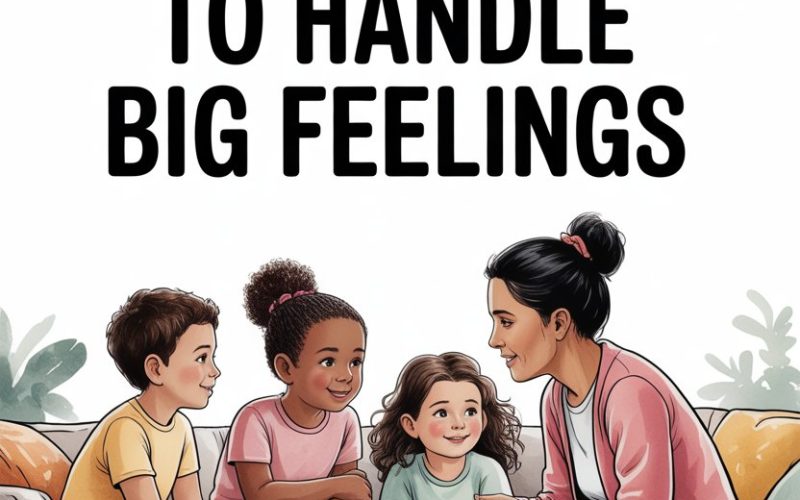You know the moment: your child’s face crumples, their tiny fists clench, and the next thing you know, you’re getting a front-row seat to the latest episode of Meltdown Masterchef—where the main ingredient is feelings, and subtlety is absolutely not on the menu.
Children are experts at feeling everything all at once: pure joy, fiery rage, heartbreak over the broken blue crayon.
The trick isn’t to extinguish these emotions, but to give our children the toolkit to handle them, channel them, and—fingers crossed—avoid redecorating your kitchen with spaghetti in the process.
Here’s your survival guide to raising emotionally savvy kids (without needing a psychology degree or a bottomless wine glass).
Name It to Tame It
Research from the University of California, Los Angeles, has found that simply labeling emotions—naming them out loud—can significantly calm the brain’s fear center.
Sounds impressive, but it boils down to this: help your child put words to what’s happening inside.
When your little one is on the verge of volcanic eruption, you might say, “You look frustrated. Is that right?” or “It seems like you’re feeling really sad.”
It’s not about solving the problem instantly. Naming feelings normalises them. It tells kids, Hey, your anger isn’t a monster under the bed—it’s just anger.
And once you know what it’s called, you can decide what to do about it.
Model Emotional Honesty
Children are the world’s best undercover detectives. They’ll spot the twitch in your eyebrow when you say, “Mummy’s FINE,” even as you grit your teeth and scrub jam off the cat.
If you want your child to be open about emotions, let them see you do it—warts, tears, and all.
Instead of bottling it up, narrate your own feelings in age-appropriate ways: “Daddy’s really disappointed the car broke down, but I’ll take some deep breaths and figure out what to do.”
This doesn’t mean turning your child into your therapist (no pressure, small person!), but it does show them that feelings aren’t scary or shameful.
Validate Before You Educate
When your child is in full emotional hurricane mode, resist the urge to leap straight to solutions or lectures. “You need to calm down!” or “Why are you crying about something so silly?” might seem logical, but they often shut kids down.
Instead, try reflecting what you see. “It’s really hard when your tower falls over, isn’t it?” or “You wanted that biscuit so much, and now you’re angry.”
This validation doesn’t mean you agree with the behaviour (throwing Lego at the dog is still a no-go), but it shows your child their feelings make sense. Once they feel heard, their brain is far more able to learn better coping skills.
Teach Them What Calm Feels Like
Expecting a child to “just calm down” is a bit like asking a puppy to drive a car. They’ve got the energy, but they’re missing some key skills.
Introduce calming techniques when everyone’s regulated—ideally, not in the eye of the storm.
Here are a few simple ones to try:
- Butterfly hugs: cross arms and gently tap shoulders alternately.
- Belly breaths: place a hand on the tummy and feel it rise and fall.
- Blowing bubbles: great for practising steady breathing (and who doesn’t love bubbles?).
Practice together, make it a game, or do a goofy demonstration yourself. When things get heated in future, remind them, “Shall we try our dragon breathing?”
Keep Limits, But With Empathy
Big feelings don’t give kids a free pass to trash the lounge room or say something mean.
Empathy and boundaries travel together. “It’s okay to be angry, but it’s not okay to hit.” Or, “You can feel disappointed, and I won’t let you throw toys.”
The trick? Stay calm, keep your voice steady, and enforce limits without shaming. Kids aren’t little adults; their brains are still under construction, especially the bits responsible for impulse control.
Gentle, consistent limits help them feel safe—even when they’re acting like a small tornado with shoes.
Create a Feelings-Rich Environment
Kids learn about emotions everywhere—in storybooks, TV shows, even the checkout queue at the shops when a stranger is huffing about the price of bananas.
Make emotions part of daily conversation. Point out characters’ feelings in stories: “How do you think Spot feels when he loses his ball?” Or ask your child to guess how a friend might feel after a tough day.
Some families use “feelings charts” or colour wheels on the fridge, offering kids a simple visual to pinpoint what they’re feeling. (Bonus: if your child can point to “volcano angry,” you’ll know to hide the good crockery.)
Encourage Problem-Solving, Not Perfection
Nobody gets feelings right every time—not even you (remember the time you nearly wept over a lost sock?). When your child is ready, brainstorm ways they might handle big feelings next time.
“When you feel mad, what could you do?” “If you’re nervous, would it help to squeeze your worry stone or sing a silly song?”
Resist the urge to fix it all for them. Ask questions, offer choices: “Do you want a hug now or do you need some space?” Little by little, you’ll help them build an emotional first-aid kit of their own.
Let Movement Do Some Heavy Lifting
Bodies and feelings are best mates, especially for children. When big emotions bubble up, movement helps.
Encourage your child to stomp, jump, run, stretch, or shake it out like a wobbly jelly. Dance party in the lounge room? That counts. Soccer ball in the garden? Perfect.
Physical activity burns off that flood of stress chemicals and gives kids a tangible way to reset. Plus, it’s harder to stay cross when you’re pretending to be a crab.
Stories and Play: Your Secret Weapons
Pretend play is the original emotional sandbox. When your child acts out feelings with toys—crying teddy, angry dinosaur—they’re processing real experiences in a way that’s safe and manageable.
Join in now and then. “Poor dolly looks so sad! What can we do to help her?”
Bedtime stories are another goldmine. Picture books like “The Colour Monster” by Anna Llenas or “When Sophie Gets Angry—Really, Really Angry” by Molly Bang are brilliant conversation starters.
Even older kids can benefit from chats about movie characters who struggle and grow.
Watch for Patterns, Not Perfection
Spotting patterns in your child’s meltdowns is like being a detective with a magnifying glass and a cup of cold coffee. Is it always just before tea? After a long day? Around certain friends?
Noticing these triggers doesn’t mean you can avoid all upsets, but sometimes a little tweak to the routine (hello, snack time) makes a world of difference.
At the same time, accept that messy feelings are part of growing up. Even the calmest kid will have a day when everything falls apart.
The goal isn’t to raise a robot—it’s to raise a human who can stumble, feel, and try again.
When to Call in the Cavalry
Every parent has been there: you’ve tried the empathy, the breathing, the stories—and still, your child’s big feelings seem overwhelming.
Occasionally, those emotions are so big they start to interfere with sleep, school, or friendships, or lead to aggressive or withdrawn behaviour that just won’t budge.
If that sounds familiar, don’t hesitate to reach out to a child psychologist, therapist or counsellor. Support from a qualified professional can make a world of difference, and there’s no shame in bringing in extra help.
Many children benefit from approaches like cognitive-behavioural therapy (CBT) or play therapy to build emotional skills.
Growing Together
Teaching kids to handle big feelings isn’t a one-off conversation—it’s a lifelong dance, full of stumbles and surprising pirouettes. Some days, you’ll feel like a Zen master.
Other days, you might contemplate running away to join the circus. Both are normal.
Every time you help your child name, accept, and work through their feelings, you’re building a foundation for resilience, empathy, and self-awareness.
And every now and then, you’ll see it click: the deep breath, the pause, the tiny voice saying, “I’m sad, but I can try again.” That’s the magic.
Hang in there. You’ve got this.
And next time you’re tempted to yell “Use your words!” maybe you’ll both reach for a bubble wand—or just share a laugh, knowing you’re in good company.





